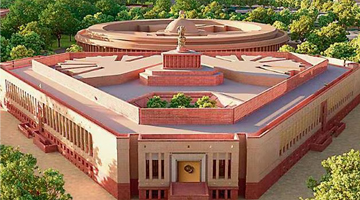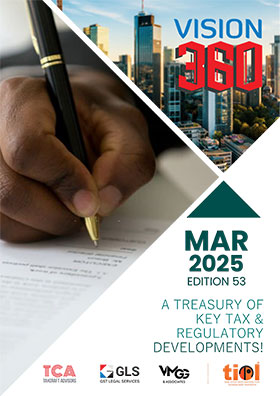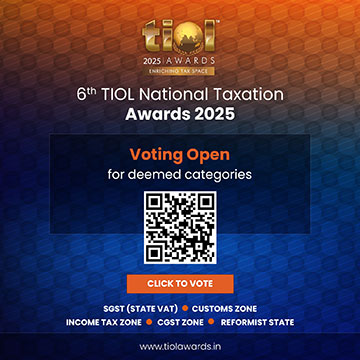Etched in stone - Oldest record of revenue evasion
AUGUST 04, 2021
By JP Singh, Principal Commissioner & Manish Mohan
 A rock inscription from AD 1169 provides for evidence of forgery reported in the Gahdavala kingdom in Bihar when some Brahmins fraudulently collected revenues from two villages in what is now modern-day Sasaram. The inscriptions show king Vijay Chandra of the Gahadvala dynasty had granted permission to some people to collect revenues from those two villages. But it emerged later that the copperplate on which the charter for collection of revenues was issued was fabricated by the Brahmins of Suvarnahla with the help of a government officer. The forgery was discovered and punished as per epigraphic evidence. These details apparently turn out to be the oldest record of evasion of revenue in our country. Let's delve deeper into this accidental discovery for us.
A rock inscription from AD 1169 provides for evidence of forgery reported in the Gahdavala kingdom in Bihar when some Brahmins fraudulently collected revenues from two villages in what is now modern-day Sasaram. The inscriptions show king Vijay Chandra of the Gahadvala dynasty had granted permission to some people to collect revenues from those two villages. But it emerged later that the copperplate on which the charter for collection of revenues was issued was fabricated by the Brahmins of Suvarnahla with the help of a government officer. The forgery was discovered and punished as per epigraphic evidence. These details apparently turn out to be the oldest record of evasion of revenue in our country. Let's delve deeper into this accidental discovery for us.
Historically, record keeping has been the most important part of any revenue collection system and through records itself, evasion of revenue could be detected. Modern economic theories also indicate that developed civilisations have robust revenue collection systems, and to that extent, the obsession of our revenue departments with revenue collection is justified to some extent historically. While thinking of some historical records of revenue collection and revenue evasion in our country, we were certain of the essential requirement that it should be available in the native language, as the development of record-keeping in our country indicates that it has been done mostly in foreign languages only. We had a hunch that there should certainly be some reference to the revenue collection in the Indian Epigraphy. Britannica defines the term epigraphy as;
"Epigraphy, the study of written matter recorded on hard or durable material. The term is derived from the Classical Greek epigraphein ("to write upon, incise") and epigraphe ("inscription")."
So, the best way to start our research work was to start with the information made available by the Archaeological Survey of India (ASI) on the subject of epigraphy in India. We found that they have published an article on this subject, and that is available on their website (Six Decades of Indian Epigraphy (1950 - 2010) Sanskrit and Dravidian inscriptions). It didn't take much time when we stumbled upon the following section.
X. Gahadavala
This rock inscription of Pratapadhavala at Tarachandi, Shahabad district, Bihar, dated Vikrama 1225 (AD 1169), records an announcement by Mahanayaka Pratapadhavala, the lord of Japila, to the effect that the brahmins of Svarnahala, or Suvarnahala, had bribed Deu, a servant of king Vijayachandra of Kanyakubja, and received from him a forged copperplate grant by virtue of which they were fraudulently enjoying two villages called Kalahand and Vadayilo. The document was signed by maharaja-putra Satrughna.
A copperplate inscription, now preserved in the Allahabad Museum, records a grant of the Gahadavala king Govindachandra issued in the Vikrama year 1711 (AD 1115). A later Gahadavala king named Avadakkamalla is mentioned in a Kausambi inscription of the Vikrama year 1294 (AD 1238).
This rock inscription vividly indicated a forgery of the grant by forging the copperplate received by bribing the government official on the strength of which revenue collection from the two villages namely Kalahand and Vadayilo were being evaded. Further, a quick google search indicated that these inscriptions were located at the Tarachandi Temple near Sasaram, in the erstwhile Shahabad district of Bihar (now Rohtas/Kaimur district) which the authors have visited several times during their childhood. So, curiosity on this issue kept us personally captivated.
Out of the curiosity, we kept thinking about these inscriptions as to how it looks, but its photograph was not available over the internet. There are enough details of the Tarachandi temple on the internet, but no photo of the inscription was available anywhere. Finally, to our delight, one indulgent subscriber posted it on Facebook and that is being reproduced for our indulgent readers to behold.
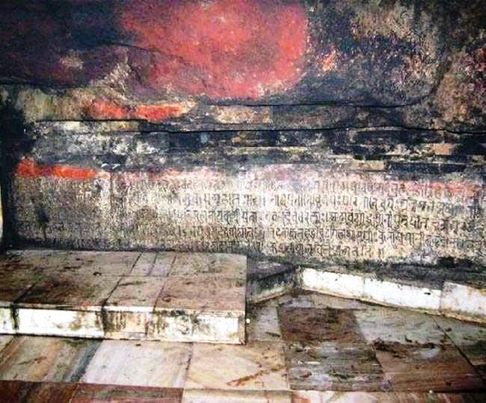
This discovery further fuelled our curiosity as to the script it has been written in, and also what is the language of this inscription? And above all, what is the message of the inscriptions? Further research on the issue indicated the availability of a review of Indian Archaeology for the year 1060-61 published by the Archaeology Survey Of India, Janpath, New Delhi. It was found that it was edited by its Director-General, Mr A. Ghosh. It has a brief reference to this inscription on page 44 under para 20 as the following.
20. SPURIOUS GAHADAVALA CHARTER, SONHAL, DISTRICT SHAHABAD. - Dated Vikrama- samvat 1223, the charter records the grant of the villages of Badaila and Kirihindi to the Brahmanas of Svarnahala. It is this record that was declared to be a spurious document by nayaka Pratapadhavala of Japila in his well-known Tarachandi inscription of Vikrama- samvat 1225.
This also confirmed only the part of the article that was available on the website of the ASI as per above details. We are not historians or archaeologists but the curiosity regarding grant of a village, based on a spurious document, that was a forged copperplate in the instant case, kept us intrigued, and we kept searching for further details of these inscriptions that would elucidate the fact whether there was anything written about the evasion of revenue or not?
We kept searching over the internet and finally one day we stumbled upon a real book on inscriptions by a specialist on this subject. THE INSCRIPTIONS OF BIHAR (From the earliest times to the middle of 13th century A.D.) written by Dr Bhagwant Sahai, M.A., PhD. University Professor and Head of the Department of Ancient Indian History and Archaeology, Patna University was the book. This was a book on a very specific subject of the inscriptions of Bihar, and we were hopeful that it would certainly be able to satisfy our curiosity. Page 118, 119 and 120 of this book have the details of this inscription in detail, and it also narrates the whole story behind it. Further, it has a detailed narration of the whole story of evasion of revenue by way of forging the document that was in the form of a copperplate. For proper appreciation of the issue, the pages concerned are being reproduced.
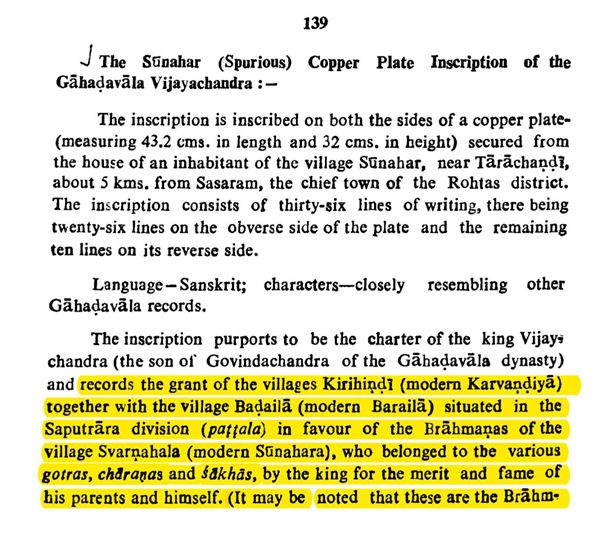
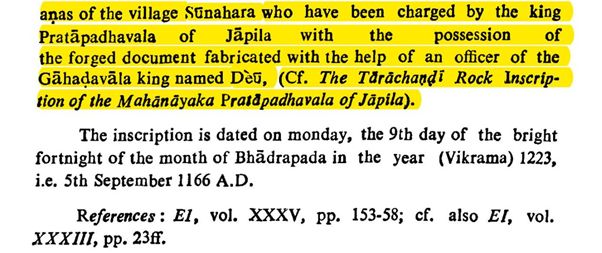
So, this copper plate indicates that a certain king Pratapadhavala had granted two villages but later the recipients were later charged by the King of possessing forged documents in the Tarachandi Rock inscriptions, details of which are figuring in the book in para 141 as the followings.

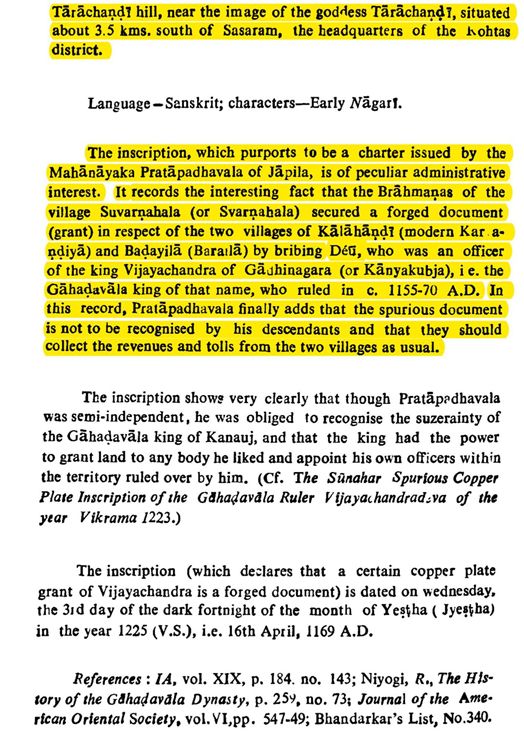
To our surprise, it turned out to be an interesting inscription so far our original curiosity about the evasion of revenue is concerned. It was noticed that it was written in the Sanskrit language and the script of it was early Nagri; which was apparently popular in those days. And finally, it proclaimed certain important messages. It records the interesting fact that the Brahmanas of the village Suvarnahala (or Svarnahala) secured a forged document (grant) in respect of the two villages by bribing Deu, who was an officer of the king. And it finally adds that the spurious document is not to be recognised by his descendants and that they should collect the revenues and tolls from the two villages as usual.
When we realised the implications of this royal proclamation, it kept us wondering as to how much it is relatable to the modern days' administration of revenue collection, besides being the oldest record of evasion of revenue. Some prevalent modes of evasion of revenue appear to have directly relatable to the above details of the year 1155-70 AD, which is almost a thousand years ago.
1. To commit an evasion of revenue, you need to know the law thoroughly as in this case the copperplate, granting the two villages, itself, was forged. Also, this forgery was committed by Brahmanas who apparently knew about the records on the strength of which revenue collection was being made.
2. To avail benefits, the government officials could also be bribed, as it was done in this case when an officer of the king named Deu was bribed by Brahmins to secure the grant. So, the collection of bribes by corrupt officials also has a long history written in the rock inscriptions.
3. Forged exemption notification has also a long history (availing ineligible exemption notifications: Most of the DRI cases come into this category).
4. Forged Invoices (Used nowadays mostly to avail ineligible GST credit)
5. Detection of the forged document, in this case, the copperplate, has the precursor of the works done by the preventive agencies working in the areas of detection of fraud.
You can add as many prevalent modes of evasion of revenue to the list, resembling one that is available in the above-detailed rock inscription. Further, it appears that the frauds mentioned above could have been similarly committed in other geographical regions too. But we are almost certain that this is the oldest record of evasion of revenue in our country, and revenue collectors and other preventive agencies could also correlate their work in the historical context of our Indian traditions.
[Jai Prakash is a humanist and history enthusiast besides being a sympathetic tax administrator. Manish has amateurish interests in history and philosophy, and his lifestyle blogs could be read at mindfulmanish.blogspot.com. The views expressed in the article are strictly personal.]
| (DISCLAIMER : The views expressed are strictly of the author and Taxindiaonline.com doesn't necessarily subscribe to the same. Taxindiaonline.com Pvt. Ltd. is not responsible or liable for any loss or damage caused to anyone due to any interpretation, error, omission in the articles being hosted on the site) |









 A rock inscription from AD 1169 provides for evidence of forgery reported in the Gahdavala kingdom in Bihar when some Brahmins fraudulently collected revenues from two villages in what is now modern-day Sasaram. The inscriptions show king Vijay Chandra of the Gahadvala dynasty had granted permission to some people to collect revenues from those two villages. But it emerged later that the copperplate on which the charter for collection of revenues was issued was fabricated by the Brahmins of Suvarnahla with the help of a government officer. The forgery was discovered and punished as per epigraphic evidence. These details apparently turn out to be the oldest record of evasion of revenue in our country. Let's delve deeper into this accidental discovery for us.
A rock inscription from AD 1169 provides for evidence of forgery reported in the Gahdavala kingdom in Bihar when some Brahmins fraudulently collected revenues from two villages in what is now modern-day Sasaram. The inscriptions show king Vijay Chandra of the Gahadvala dynasty had granted permission to some people to collect revenues from those two villages. But it emerged later that the copperplate on which the charter for collection of revenues was issued was fabricated by the Brahmins of Suvarnahla with the help of a government officer. The forgery was discovered and punished as per epigraphic evidence. These details apparently turn out to be the oldest record of evasion of revenue in our country. Let's delve deeper into this accidental discovery for us.







